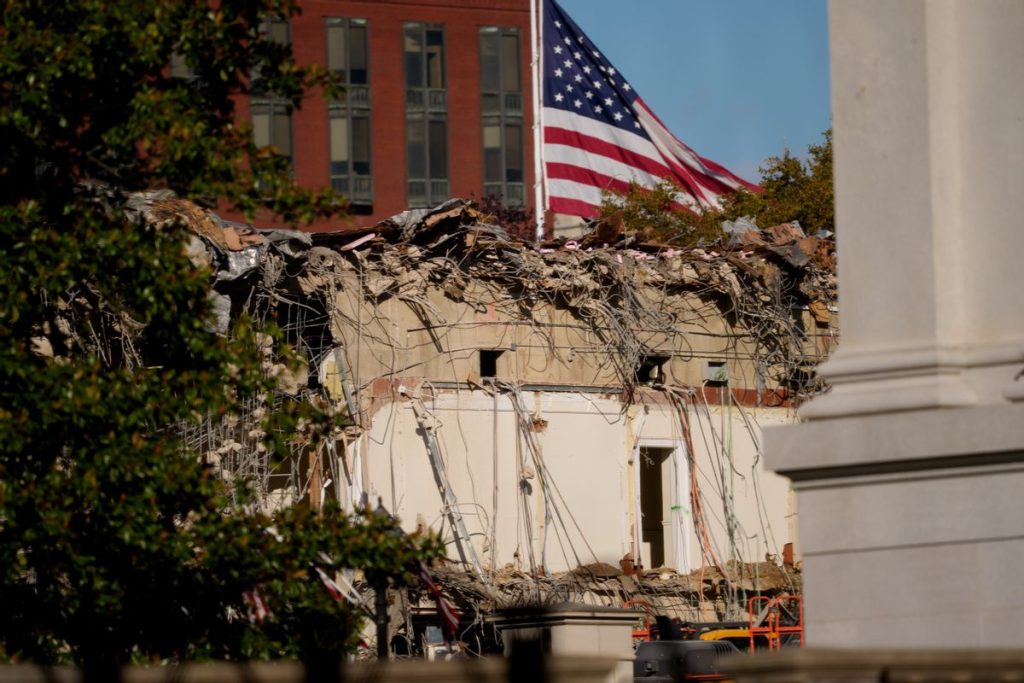Listen to the article
In a dramatic development that has shocked many Americans, the entire East Wing of the White House has been demolished as part of President Donald Trump’s controversial plan to construct a new ballroom at the historic site.
Construction crews completed the teardown of both the East Wing and the East Colonnade on October 23, 2025, removing structures that had stood for more than a century. The demolition came despite Trump’s earlier promises in July 2025 that his ballroom project would not “interfere with the current building.”
On October 22, Trump confirmed the demolition to reporters during an Oval Office meeting. “In order to do it properly, we had to take down the existing structure,” the president said while displaying renderings of the planned ballroom. The project’s estimated cost has risen from an initially announced $200 million to $300 million, according to Trump, who stated the funds would come from himself and a group of private donors.
Photographs from reputable news sources, including The Associated Press, have documented the demolition process. By October 21, most of the building was gone, with only narrow portions of the north and western façades remaining. One particularly striking image, published by legal reporter Chris Geidner on his website Law Dork, showed the extensive destruction when viewed from the Treasury Department building.
The Washington Post first reported on the East Wing’s demolition on October 20, with several other major news outlets subsequently confirming that the project had begun. Initially, it remained unclear how much of the existing structure would be removed, but by week’s end, the entire East Wing had been razed.
The demolition has sparked significant criticism. MSNBC host Rachel Maddow shared news of the teardown on social media with the caption “omg!” Former Secretary of State Hillary Clinton, who lost to Trump in the 2016 presidential election, wrote on Bluesky: “It’s not his house. It’s your house. And he’s destroying it.”
The East Wing has played an important role in White House history since its construction in 1902 during Theodore Roosevelt’s presidency. The structure was significantly expanded in 1942 under President Franklin D. Roosevelt to cover the bunker he used during World War II, which later became the Presidential Emergency Operations Center.
In recent decades, the East Wing housed the offices of the first lady, her staff, and the White House social secretary. It also served as the visitors’ entrance for public tours of the presidential residence. The White House’s movie theater was located inside the now-demolished East Colonnade.
The new ballroom that Trump plans to build will reportedly be nearly twice the size of the White House itself, according to Associated Press reports. This dramatic alteration to one of America’s most iconic buildings raises significant questions about the preservation of historic structures and the limits of presidential authority over national landmarks.
The demolition represents one of the most substantial physical changes to the White House complex in decades. While presidents have frequently made modifications to the interior of the White House to suit their personal tastes or functional needs, the complete removal of an entire wing is unprecedented in modern history.
As construction proceeds, the controversy is likely to continue, with preservationists, historians, and political observers debating whether such dramatic alterations to the “People’s House” should be permitted, regardless of who occupies the Oval Office.
Verify This Yourself
Use these professional tools to fact-check and investigate claims independently
Reverse Image Search
Check if this image has been used elsewhere or in different contexts
Ask Our AI About This Claim
Get instant answers with web-powered AI analysis
Related Fact-Checks
See what other fact-checkers have said about similar claims
Want More Verification Tools?
Access our full suite of professional disinformation monitoring and investigation tools




10 Comments
While I understand the desire to modernize the White House, the demolition of the East Wing is concerning. That wing has stood for over a century and is integral to the building’s character. I hope the new ballroom can be integrated sensitively.
Agreed, preserving historical architecture is important, especially for such an iconic building as the White House. Hopefully the renovation can strike a balance between updating functionality and respecting the original design.
Interesting development with the East Wing renovation. I wonder how this will impact the historic architecture and layout of the White House. While change can be necessary, I hope they can preserve as much of the original design as possible.
Agreed, the White House is an iconic building with deep historical significance. Any major renovations should be approached carefully to balance practical needs with preserving the character and legacy of the structure.
A $300 million price tag for a White House renovation seems excessive, even with private donors involved. I wonder if those funds could be better utilized for more pressing national priorities. The public will surely scrutinize this project closely.
A $300 million ballroom project seems quite extravagant. I understand the desire to modernize, but that’s a hefty price tag for taxpayers to foot. Curious to see the final design and whether it will be worth the investment.
Good point. With the country facing economic challenges, that level of spending on a White House renovation raises questions about priorities and fiscal responsibility. The public will likely want to see strong justification for the costs.
Demolishing historical parts of the East Wing is a bold move. I hope the new ballroom can capture the spirit of the original architecture, rather than feeling out of place. Curious to see renderings of the planned design.
While I understand the desire for change, demolishing historical parts of the White House is a bold and concerning move. I hope the new ballroom design can seamlessly integrate with the existing architecture in a way that honors the building’s legacy.
Agreed, the White House has immense historical and cultural significance. Any major renovations should be approached with great care and sensitivity to preserve the building’s iconic character.